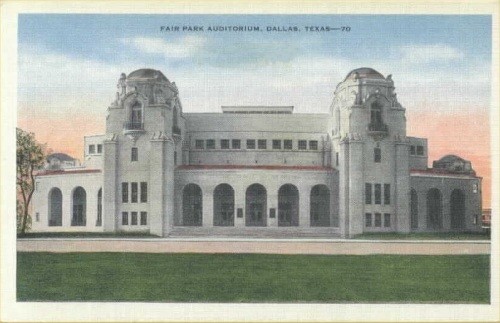Dallas Music Hall at Fair Park
Introduction
Text-to-speech Audio
Opened in 1925, the Dallas Music Hall at Fair Park was built on the previous site of Cycle Park, a wooden racetrack established 1896. Along with the track for bicycle races, the site also hosted theater events on an outdoor stage until 1903, when the structure burned down. Thereafter, the site became known as Gaston Park, with the land leased by the Dallas Baseball League. In 1925, a new building, the Fair Park Auditorium, was designed and built in the Spanish Baroque style. The venue was used as a concert hall for public events during the 1936 Texas Centennial Exposition, and it was the home stage of the Dallas Opera from 1957 to 2009. Following a renovated completed in 1999, the Music Hall began hosting Broadway musicals and other theatrical productions. It is currently home to Broadway Dallas.
Images
Music Hall at night, circa 2023

"Fair Park Auditorium" (1925), as the Music Hall was then known

Aerial view, Texas Centennial Exposition (1936)

The original Bandstand (Bandshell) at Fair Park, where the Starlight Operettas were initially staged before moving into the Music Hall

Upon taking up residence in the Music Hall at Fair Park, Starlight Operettas was renamed "State Fair Musicals" in 1951

Music Hall at Fair Park, circa 1960s

Live theatrical performance at the music hall

Today, Broadway Dallas, which is based at the Music Hall hosts national touring companies and Broadway shows, such as "Hamilton"

Post-renovation Music Hall

Post-renovation Music Hall

Show night: Interior of the Music Hall

Music Hall exterior at night

Backstory and Context
Text-to-speech Audio
Designed by the architectural firm of Lang & Witchell in the Spanish Baroque style, the Music Hall at Fair Park opened in 1925 as a civic auditorium. Located at the site of the Texas State Fairgrounds established in the 1880s, the Music Hall then served as a public concert venue during the 1936 Texas Centennial Exposition, which was held at Fair Park. Although some of temporary buildings constructed for the exposition were demolished thereafter, others still remain standing today. In 1941, another nearby structure known as the Fair Park Bandstand began to host a musical program called "Opera Under the Stars," funded by city business leaders in conjunction with the New York-based theatrical production company, the Shubert Organization.
The company's first outdoor theatrical production at Fair Park was the play, Blossom Time. It featured the life and music of the early nineteenth-century Austrian composer, Franz Schubert. Producers decided to stage the performances outside at the Fair Park Bandstand, instead of indoors at the Music Hall, because the hall had no air conditioning. The first run of the show was an unexpected success, despite the soaring temperatures and frequent rain. However, the bombing of Pearl Harbor in December 1941 shifted the nation's focus, and the subsequent involvement of the U.S. in World War II disrupted plans for the next summer season of entertainment at Fair Park.
Still, the show must go on, and fortunately, a non-profit organization was formed by local business leaders to carry out a performance schedule under the name "Starlight Operettas." The State Fair Association also had some control over the productions, since the performances were staged at Fair Park, the annual fairgrounds. The Association decided to appoint Charles R. Meeker, Jr., as the first executive director of Starlight Operettas. Meeker had previous experience running vaudeville shows, and by 1945, he was able to turn the summer concert and theater series at Fair Park into a leading attraction. He booked national touring companies, featured the most popular musicals, and made modifications to the bandstand to so that performances would run more smoothly. The summer concert series at Fair Park drew popular stars such as Judy Garland, Mary Martin, Jack Benny, and Debbie Reynolds.
In 1951, Starlight Operettas moved into the Music Hall building, which by then was air-conditioned. The company's name was changed to State Fair Musicals, although Meeker left in 1961 for a position as Musical Director at Six Flags Over Texas. In his place, Tom Hughes took over the program at Fair Park, and State Fair Musicals was renamed Dallas Summer Musicals. A major renovation in 1972 saw the addition of the Crystal Terrace Restaurant, an expanded lobby, an indoor box office, and improved acoustics. The theater program continued to grow over the next several decades. In 1994, Michael Jenkins stepped up to lead the company as Executive Director. In 1999, another upgrade saw the addition of a guest relations center and gift shop, positioning the venue for the twenty-first century. Today, the Music Hall at Fair Park continues to host popular shows each summer, and it is currently home to the company Broadway Dallas.
Sources
"Fair Park," City Landmark Designation Report, Dallas City Hall. Accessed April 27th, 2023. https://dallascityhall.com/departments/sustainabledevelopment/historicpreservation/HP%20Documents/Districts%20Page/Fair%20Park%20Designation%20Report.pdf.
"Fair Park," City Landmark Designation Report, Dallas City Hall. Accessed April 27th, 2023. https://dallascityhall.com/departments/sustainabledevelopment/historicpreservation/HP%20Documents/Districts%20Page/Fair%20Park%20Designation%20Report.pdf.
Fair Park Concerts, Dallas Theater. Accessed April 27th, 2023. https://www.dallas-theater.com/theaters/music-hall-fair-park/concerts.
History, Broadway Dallas. Accessed April 27th, 2023. https://broadwaydallas.org/about/history/.
Skinner, Clint. Fair Park, National Historic Landmark (Music Hall), Texas Escapes. Accessed April 27th, 2023. http://www.texasescapes.com/DallasTexas/Dallas-Texas-Fair-Park-8-Music-Hall.htm.
Fair Park
Texas Escapes
Sarah Reveley
Broadway Dallas
Broadway Dallas
Broadway Dallas
Broadway Dallas
Broadway Dallas
Photo by Christian Waits
Photo by Christian Waits
Photo by Christian Waits
Photo by Christian Waits
